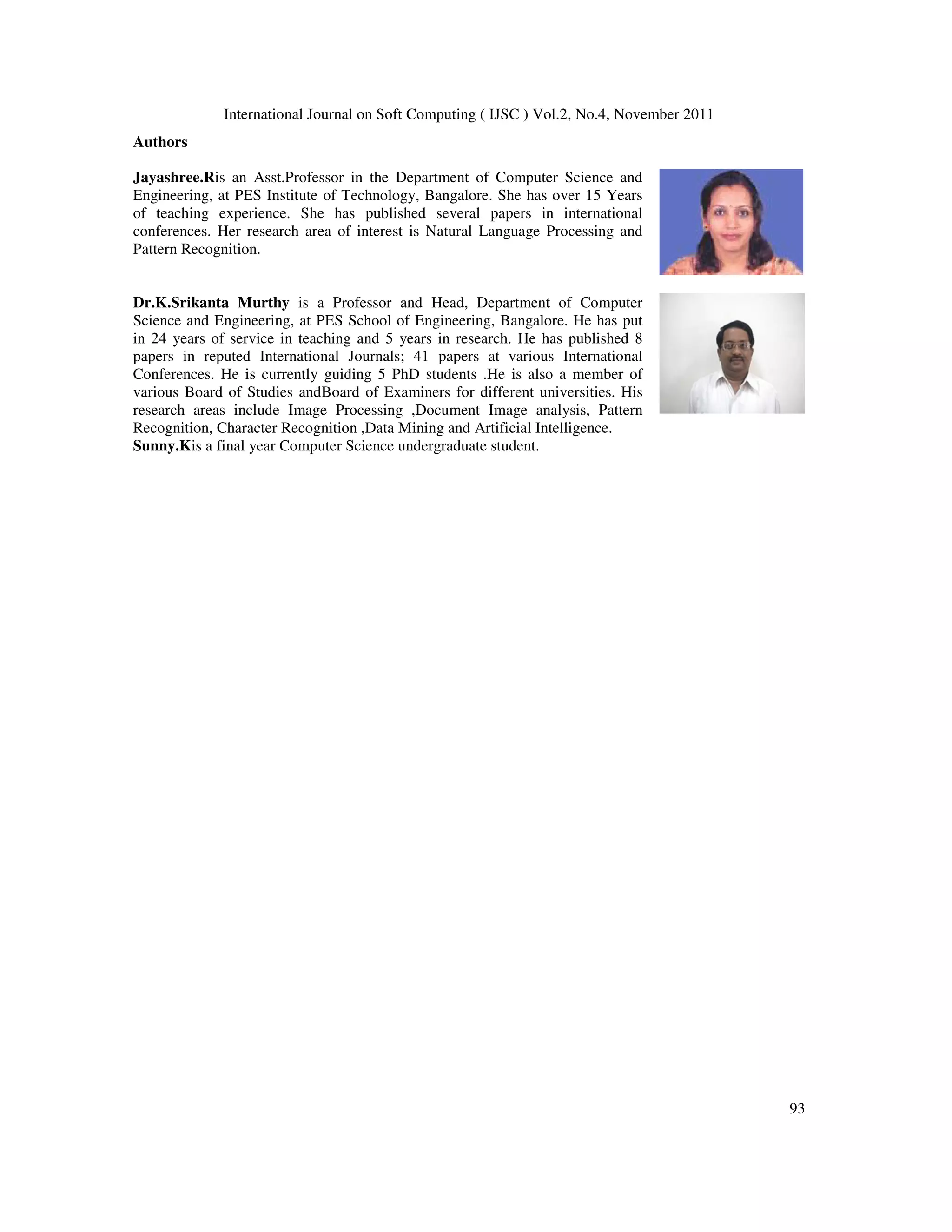The document presents a method for extractive summarization of categorized Kannada text documents using keyword extraction techniques. This approach utilizes Galavotti-Sebastiani-Simi coefficients and inverse document frequency to determine keyword relevance, allowing the generation of meaningful summaries based on user-defined sentence limits. It highlights the growing need for effective information retrieval in multilingual contexts, particularly for Kannada speakers, and discusses the challenges and solutions in developing summarization algorithms.
![International Journal on Soft Computing ( IJSC ) Vol.2, No.4, November 2011
DOI : 10.5121/ijsc.2011.2408 81
KEYWORD EXTRACTION BASED
SUMMARIZATION OF CATEGORIZED
KANNADA TEXT DOCUMENTS
Jayashree.R1
, Srikanta Murthy.K2
and Sunny.K1
1
Department of Computer Science, PES Institute Of Technology, Bangalore, India
jayashree@pes.edu, sunfinite@gmail.com
2
Department of Computer Science, PES School Of Engineering, Bangalore, India
srikantamurthy@pes.edu
ABSTRACT
The internet has caused a humongous growth in the number of documents available online. Summaries of
documents can help find the right information and are particularly effective when the document base is
very large. Keywords are closely associated to a document as they reflect the document's content and act
as indices for a given document. In this work, we present a method to produce extractive summaries of
documents in the Kannada language, given number of sentences as limitation. The algorithm extracts key
words from pre-categorized Kannada documents collected from online resources. We use two feature
selection techniques for obtaining features from documents, then we combine scores obtained by GSS
(Galavotti, Sebastiani, Simi) coefficients and IDF (Inverse Document Frequency) methods along with TF
(Term Frequency) for extracting key words and later use these for summarization based on rank of the
sentence. In the current implementation, a document from a given category is selected from our database
and depending on the number of sentences given by the user, a summary is generated.
KEYWORDS
Summary, Keywords, GSS coefficient, Term Frequency (TF), IDF (Inverse Document Frequency) and Rank
of sentence
1. Introduction
With the growth of the internet, a large amount of data is available online. There is a demanding
need to make effective use of data available in native languages. Information Retrieval [IR] is
therefore becoming an important need in the Indian context. India is a multilingual country; any
new method developed in IR in this context needs to address multilingual documents. There are
around 50 million Kannada speakers and more than 10000 articles in Kannada Wikipedia. This
warrants us to develop tools that can be used to explore digital information presented in Kannada
and other native languages. A very important task in Natural Language Processing is Text
Summarization. Inderjeet Mani provides the following succinct definition for summarization is:
take an information source, extract content from it, and present the most important content to the
user in a condensed form and in a manner sensitive to the user’s application needs[14].There are
two main techniques for Text Document Summarization: extractive summary and abstractive](https://image.slidesharecdn.com/2411ijsc08-201119102224/75/Keyword-Extraction-Based-Summarization-of-Categorized-Kannada-Text-Documents-1-2048.jpg)
![International Journal on Soft Computing ( IJSC ) Vol.2, No.4, November 2011
82
summary. While extractive summary copies information that is very important to the summary,
abstractive summary condenses the document more strongly than extractive summarization and
require natural language generation techniques. Summarization is not a deterministic problem,
different people would chose different sentences and even the same person may chose different
sentences at different times, showing differences between summaries created by humans. Also,
semantic equivalence is another problem, because two sentences can give the same meaning with
different wordings. In this paper, we present an extractive summarization algorithm which
provides generic summaries. The algorithm uses sentences as the compression basis.
Keywords/phrases, which are a very important component of this work, are nothing but
expressions; single words or phrases describing the most important aspects of a given document.
The list of keywords/phrases aims to reflect the meaning of the document. Guided by the given
keywords/phrases, we can provide a quick summary, which can help people easily understand
what a document describes, saving a great amount of time and thus money. Consequently,
automatic text document summarization is in high demand. Meanwhile, summarization is also
fundamental to many other natural language processing and data mining applications such as
information retrieval, text clustering and so on [11][2].
2. Literature Survey
Previous work on key phrase extraction by Letian Wang and Fang Li [3] has shown that key
phrase extraction can be achieved using chunk based method. Keywords of document are used to
select key phrases from candidates. Similarly, another approach by Mari-SannaPaukkeri et al[2]
selects words and phrases that best describe the meaning of the documents by comparing ranks of
frequencies in the documents to the corpus considered as reference corpus. The SZETERGAK
system by Gabor Berend[1] is a frame work that treats the reproduction of reader assigned
keywords as a supervised learning task. In this work, a restricted set of token sequences was used
as classification instances. One more method of You Ouyang[4] extracted the most essential
words and then expanded the identified core words as the target key phrases by word expansion
approach. A novel approach to key phrase extraction proposed by them consists of two stages:
identifying core words and expanding core words to key phrases. The work of automatically
producing key phrases for each scientific paper by Su Nam Kim et al[5] has compiled a set of 284
scientific articles with key phrases carefully chosen by both their authors and readers, the task
was to automatically produce key phrases for each paper. FumiyoFukumoto[6] present a method
for detecting key sentences from the documents that discuss the same event. To eliminate
redundancy they use spectral clustering and classified each sentence into groups each of which
consists of semantically related sentences. The work of Michael .J . Paul et al[7] use an
unsupervised probabilistic approach to model and extract multiple viewpoints in text. The authors
also use Lex rank, a novel random walk formulating to score sentences and pairs of sentences
from opposite view points based on both representativeness of the collections as well as their
contrast with each other. The word position information proves to play a significant role in
document summarization. The work of You Ouyang [8] et al illustrates the use of word position
information, the idea comes from assigning different importance to multiple words in a single
document .Cross Language document summary is another upcoming trend that is growing in
Natural Language Processing area, wherein the input document is in one language , the
summarizer produces summary in another language. There was a proposal by Xiaojun Wan et al
[9] to consider the translation from English to Chinese. First the translation quality of each
English sentence in the document set is predicted with the SVM regression method and then the
quality score of each sentence is incorporated into the summarization process; finally English
sentences with high translation scores are translated to form the Chinese summary. There have](https://image.slidesharecdn.com/2411ijsc08-201119102224/75/Keyword-Extraction-Based-Summarization-of-Categorized-Kannada-Text-Documents-2-2048.jpg)
![International Journal on Soft Computing ( IJSC ) Vol.2, No.4, November 2011
83
been techniques which use A* algorithm to find the best extractive summary up to given length,
which is both optimal and efficient to run. Search is typically performed using greedy technique
which selects each sentence in the decreasing order of model score until the desired length
summary is reached [10]. There are two approaches to document summarization, supervised and
unsupervised methods. In supervised approach, a model is trained to determine if a candidate
phrase is a key phrase. In unsupervised method graph based methods are state-of-the art. These
methods first build a word graph according to word co occurrences within the document and then
use random walk techniques to measure the importance of a word [12].
3. Methodology:The methodology adopted by us can be described in four major steps:
3.1. Crawling
The first step is creating the Kannada dataset. Wget , a Unix utility tool was used to crawl the
data available on http://kannada.webdunia.com. Data was pre-categorized on this web site.
3.2. Indexing
Python was the language of choice. The indexing part consisted of removing HTML mark up;
English words need not be indexed for our work. Beautiful Soup is a python HTML/XML parser
which makes it very easy to scrape a screen. It is very tolerant with bad markup. We use Beautiful
Soup to build a string out of the text on the page by recursively traversing the parse tree returned
by Beautiful Soup. All HTML and XML entities (ಅ :ಅ , < : <) are then converted to
their character equivalents. Normal indexing operations involve extracting words by splitting the
document at non-alphanumeric characters, however this would not serve our purpose because
dependent vowels ( ◌ಾಹ, ◌ಾ etc.) are treated as non-alphanumeric, so splitting at non-
alphanumeric characters would not have worked for tokenization. Hence a separate module was
written for removing punctuations.
3.3. Keyword Extraction
Documents in five categories were fetched: sports, religion, entertainment, literature, astrology.
The next step is to calculate GSS coefficients and the Inverse Document Frequency (IDF) scores
for every word (in a given category in the former case) in a given document belonging to these
categories. Every word in a given document has a Term Frequency (TF), which gives the number
of occurrence of a term in a given document, defined by:
TF= frequency of a term in a document / number of terms in a given document.
Similarly, the IDF of a document is given by the formula,
IDF=Log10(N/n), where ‘N’ is the total number of documents indexed across all categories. and
‘n’ is the number of documents containing a particular term.
Hence TF and IDF are category independent. The GSS coefficients which evaluate the
importance of a particular term to a particular category are calculated. GSS(Galavotti-Sebastiani-](https://image.slidesharecdn.com/2411ijsc08-201119102224/75/Keyword-Extraction-Based-Summarization-of-Categorized-Kannada-Text-Documents-3-2048.jpg)
![International Journal on Soft Computing ( IJSC ) Vol.2, No.4, November 2011
84
Simi) co-efficient [13] is a feature selection technique used as the relevance measure in our case.
Given a word w and category c it
is defined as:
f(w , c)= p(w , c)* p( w' , c') -p( w ', c) * p( w , c')
where, p( w, c ) is the probability that a document contains word ‘w’ and belongs to category ‘c’
p( w' , c' ) is the probability that a document does not contain ‘w’ and does not belong to ‘c’
p( w' , c ) is the probability that a document does not contain ‘w’ and belongs to ‘c’
p( w , c' ) is the probability that a document contains ‘w’ and does not belong to ‘c’.
GSS coefficients give us words which are most relevant to the category to which the documents
belong. IDF gives us words which are of importance to the given documents independently. Thus
using these two parameters to determine relevant parts of the document helps in providing a
wholesome summary.
3.4. Summarization
Given a document and a limit on the number of sentences, we have to provide a meaningful
summary. We calculate the GSS coefficients and IDF of all the words in the given document. If
the document is already present in our database, GSS coefficients and IDF values are already
calculated offline. These values are then multiplied by the TF of the individual words to
determine their overall importance in the document. We then extract top n keywords from each of
the lists (GSS coefficients and IDF). Then sentences are extracted from the given document by
retrieving Kannada sentences ending with full stops. Due care is taken to see that full stops which
do not mark the end of a sentence (ಡಹ. etc.) are not considered as split points. Each of these
sentences is then evaluated for the number of keywords it contains from the GSS and IDF lists as
follows:
Rank of sentence = Number of keywords contained by the sentence from both the lists
____________________________
Total number of sentences in the document
The top ‘m’ sentences are then returned as document summary, where ‘m’ is the user specified
limit.
The same concept can be extended to paragraphs to provide a possibly more meaningful context
than individual sentences particularly in the case of large documents.
3.5. Tests
The following lists were obtained by running our algorithm with a sports article on cricket as
input with n= 20:](https://image.slidesharecdn.com/2411ijsc08-201119102224/75/Keyword-Extraction-Based-Summarization-of-Categorized-Kannada-Text-Documents-4-2048.jpg)
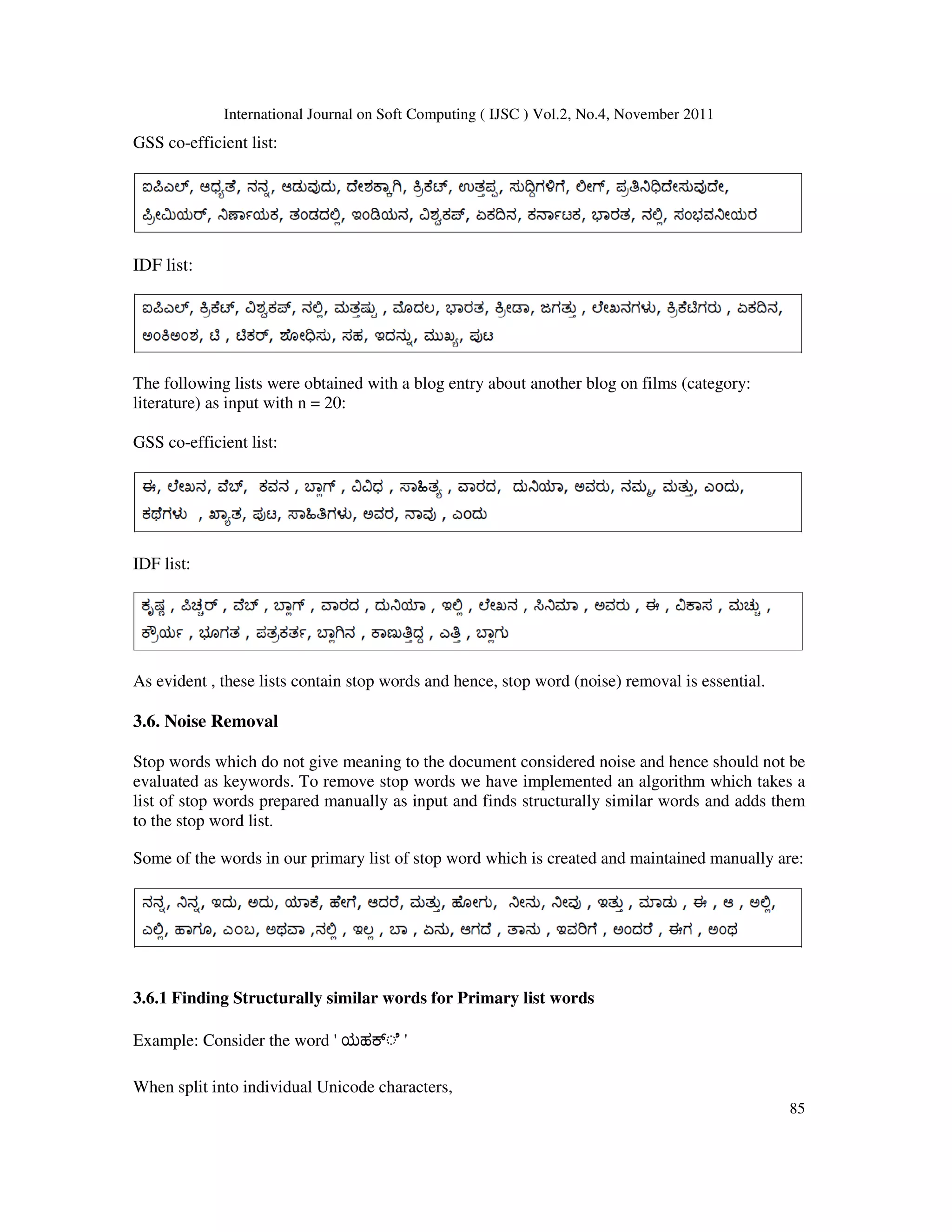
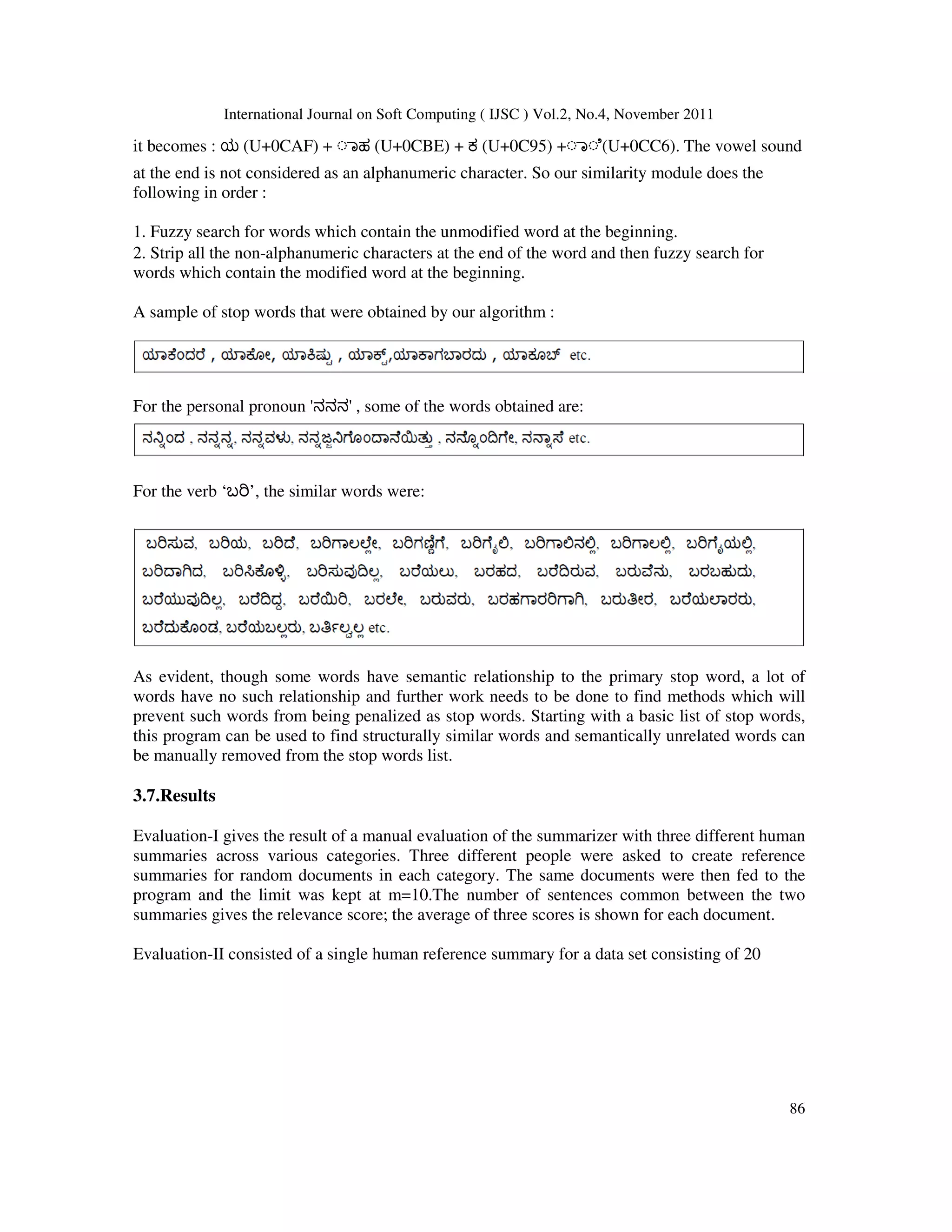

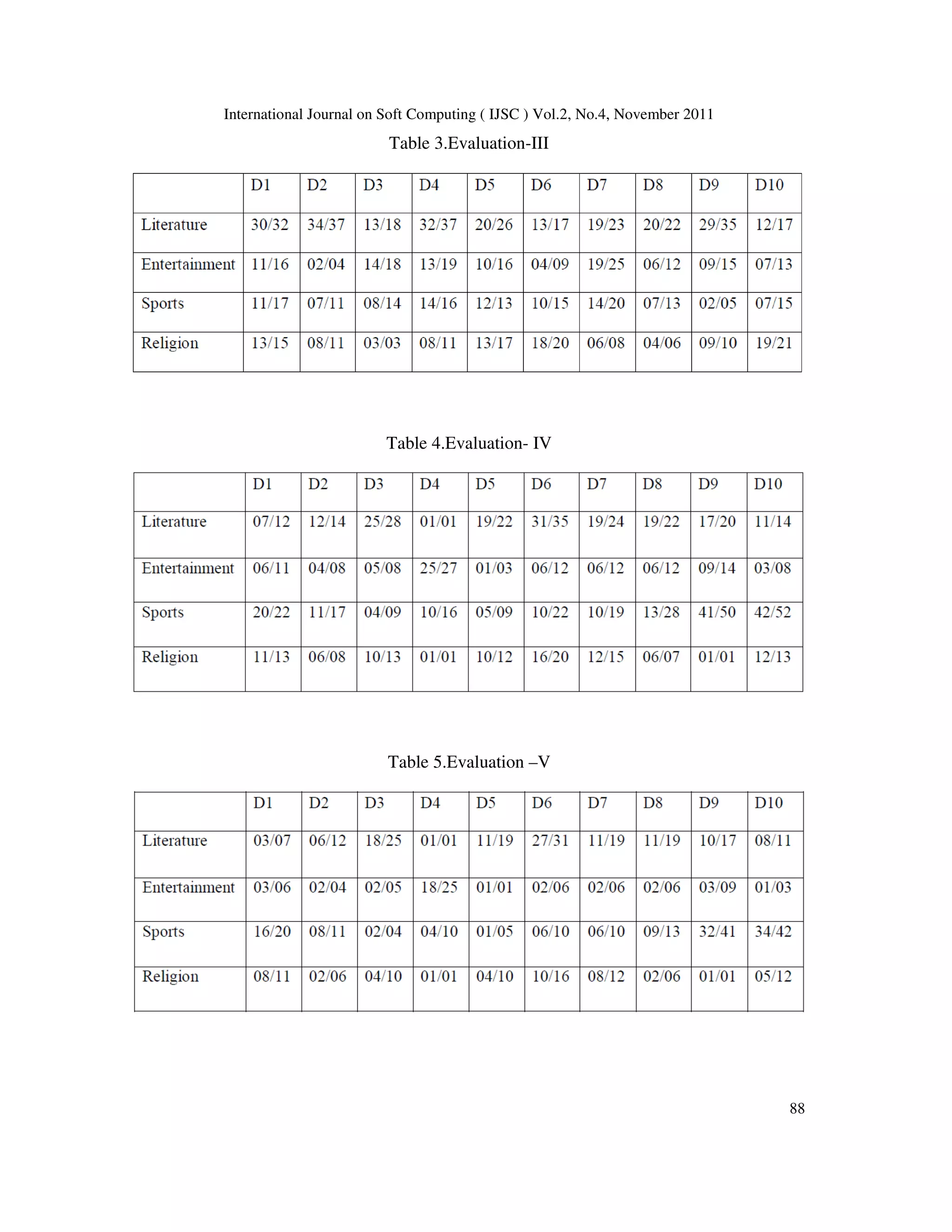
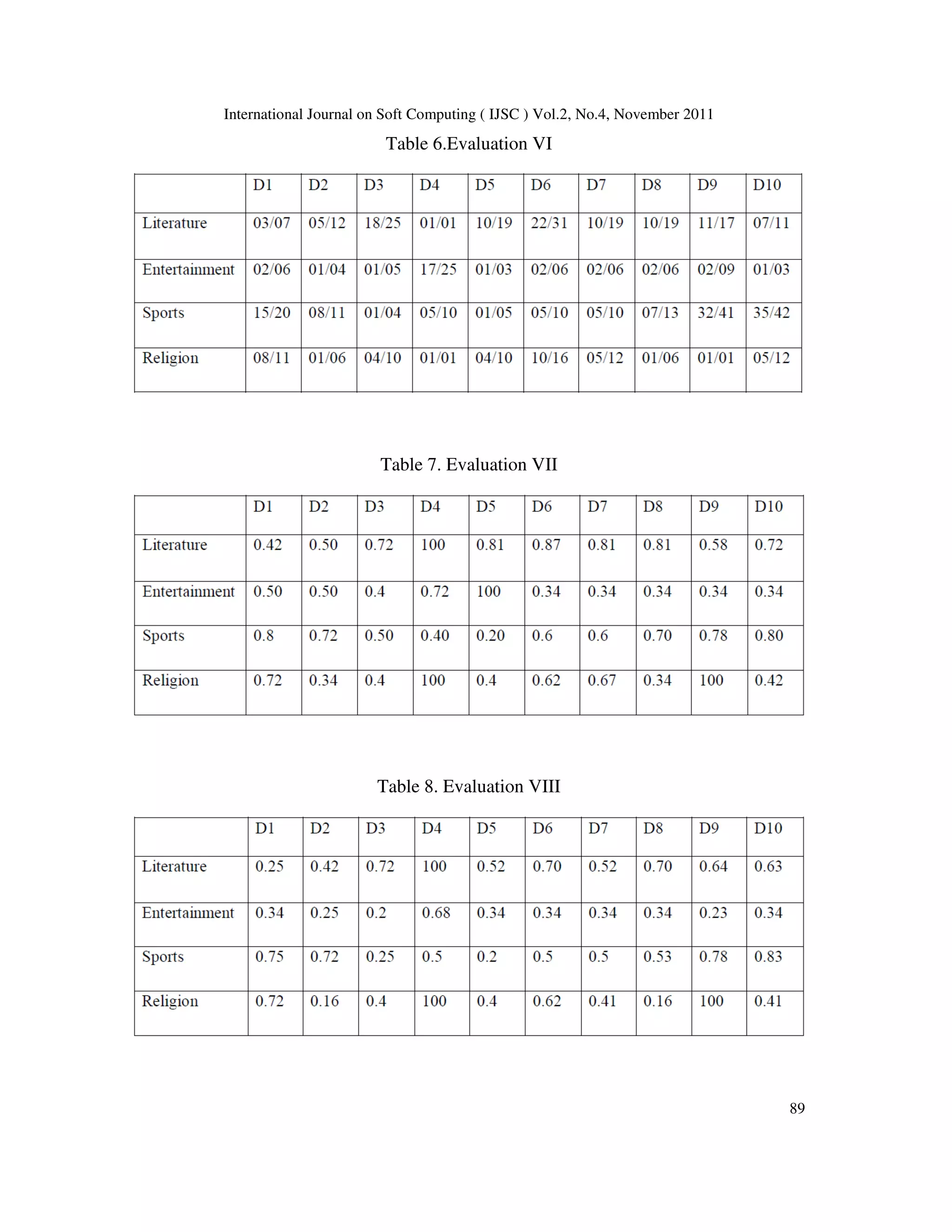
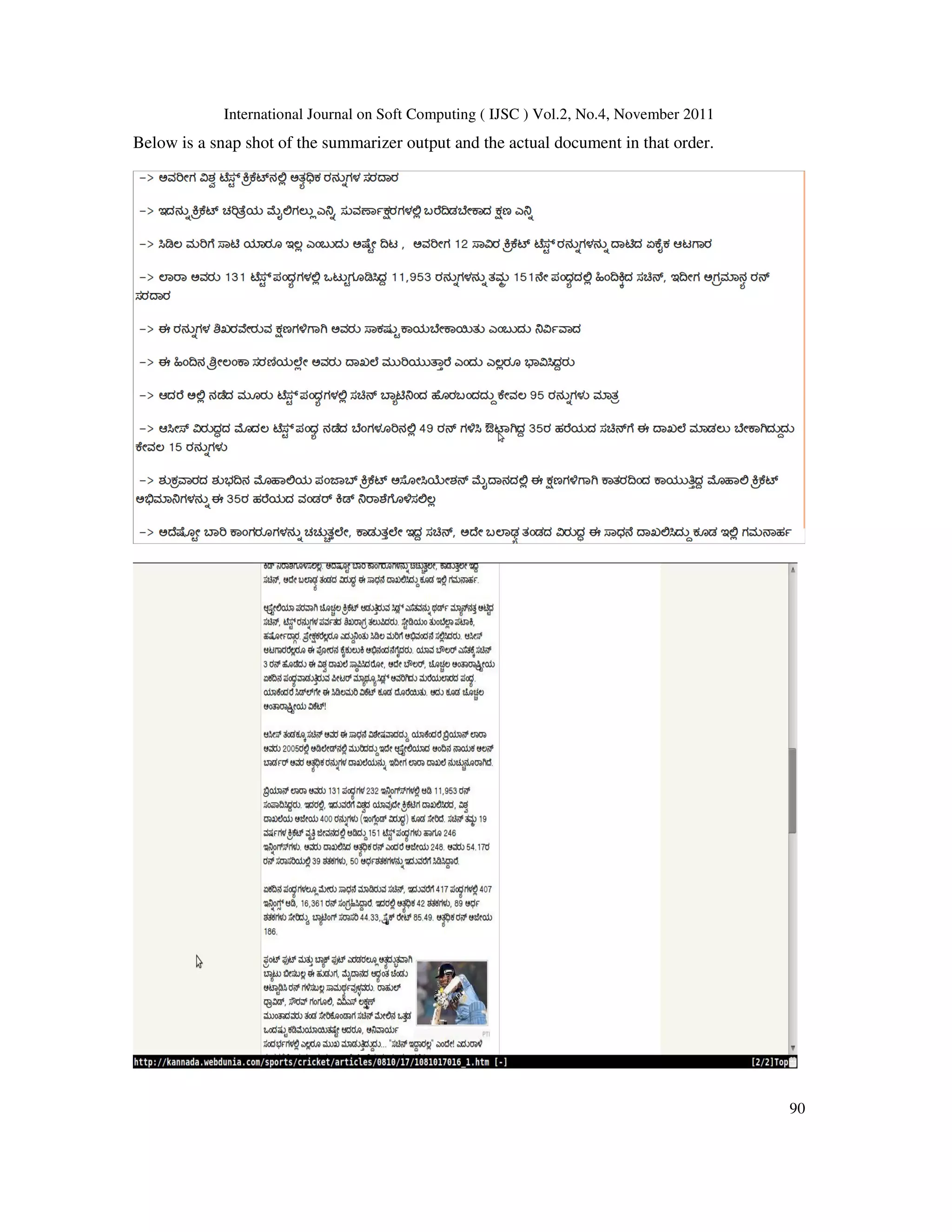
![International Journal on Soft Computing ( IJSC ) Vol.2, No.4, November 2011
91
3.8. Summarization of unclassified documents
The main purpose of classification in our work is to make efficient use of feature selection
techniques such as GSS co-efficient for summarizing documents. The same feature selection
techniques can be used to train classifiers thereby improving the efficiency of classifiers.
When an unclassified document is given as input, the stop word removal method described above
is applied. It is then submitted to the classifier which generates relevance scores depending on the
number of GSS co-efficient keywords the particular document contains. Such a method will
ensure that the classifier does not train itself on and is not misguided by frequently occurring but
non-relevant terms to a category. Once a document is classified, the procedure outlined above can
be followed.
If all the values returned by the classifier across all categories fall below the threshold, TF-IDF
can be used as the fallback for summarization.
4.Conclusion
It is evident that evaluating summaries is a difficult task, as it is not deterministic. Different
people may choose different sentences and also same people may choose different sentences at
different times. Sentence recall measure is used as the evaluation factor. Although humans can
also cut and paste relevant information of a text, most of the times they rephrase sentences when
necessary, or they join different related information into one sentence. Hence paraphrasing and
rephrasing are the issues in summarization. However in our test, sentences were selected as a
whole both by the machine and human summarizers
Most Evaluation systems in Summarization require at least one reference summary, which is the
most difficult and expensive task. Much effort is needed in order to have corpus of texts and their
corresponding summaries.
The Classifier helps determine the relevant category. Hence any document given as input is able
to produce the summary. There is no standard stop word list for Kannada, or methods to do that.
Hence a given procedure in this work can be used as a stop word removal tool using structurally
similar word removal technique. The summarizer can be used as a tool in various organizations
such as Kannada Development Authority, Kannada SahityaParishath etc.
References
[1] Gabor Berend,Rich´ardFarkasSZTERGAK : Feature Engineering for Keyphrasextraction,Proceedings
of the 5th International Workshop on Semantic Evaluation, ACL 2010, pp 186–189,Uppsala,Sweden,
15-16 July 2010.
[2] Mari-SannaPaukkeri and TimoHonkela,'Likey: Unsupervised Language-independent
KeyphraseExtraction,Proceedings of the 5th International Workshop on Semantic Evaluation, ACL
2010, pp 162–165,Uppsala, Sweden, 15-16 July 2010.
[3] Letian Wang, Fang Li, SJTULTLAB: Chunk Based Method for Keyphrase Extraction, Proceedings of
the 5th International Workshop on Semantic Evaluation, ACL 2010,pp 158– 161,Uppsala, Sweden,
15-16 July 2010.](https://image.slidesharecdn.com/2411ijsc08-201119102224/75/Keyword-Extraction-Based-Summarization-of-Categorized-Kannada-Text-Documents-11-2048.jpg)
![International Journal on Soft Computing ( IJSC ) Vol.2, No.4, November 2011
92
[4] You OuyangWenjie Li Renxian Zhang,'273. Task 5.Keyphrase Extraction Based on Core Word
Identification and Word Expansion',Proceedings of the 5th International Workshop on Semantic
Evaluation, ACL 2010, pp 142–145, Uppsala, Sweden, 15-16 July 2010.
[5] Su Nam Kim,ÄOlenaMedelyan,~ Min-Yen Kan} and Timothy BaldwinÄ,'SemEval-2010 Task 5:
Automatic Keyphrase Extraction from Scientific Articles',Proceedings of the 5th International
Workshop on Semantic Evaluation, ACL 2010, pp 21–26,Uppsala, Sweden, 15-16 July 2010.
[6] FumiyoFukumotoAkina Sakai Yoshimi Suzuki,'Eliminating Redundancy by Spectral Relaxation for
Multi-Document Summarization',Proceedings of the 2010 Workshop on Graph-based Methods for
Natural Language Processing, ACL 2010, pp 98–102,Uppsala, Sweden, 16 July 2010.
[7] Michael J. Paul,ChengXiangZhai,RoxanaGirju,'Summarizing Contrastive Viewpoints in Opinionated
Text',Proceedings of the 2010 Conference on Empirical Methods in Natural Language Processing, pp
66–76,MIT, Massachusetts, USA, 9-11 October 2010.
[8] You Ouyang ,Wenjie Li Qin Lu Renxian Zhang, ‘A Study on Position Information in Document
Summarization’, Coling 2010: Poster Volume, pp 919–927, Beijing, August 2010.
[9] Xiaojun Wan, Huiying Li and JianguoXiao,'Cross-Language Document Summarization Based on
Machine Quality Prediction',Proceedings of the 48th Annual Meeting of the Association for
Computational Linguistics, pp 917–926,Uppsala, Sweden, 11-16 July 2010.
[10] Ahmet Aker Trevor Cohn,'Multi-document summarization using A* search and discriminative
training',Proceedings of the 2010 Conference on Empirical Methods in Natural Language Processing,
pp 482–491,MIT, Massachusetts, USA, 9-11 October 2010.
[11] Hal Daum´e III*,DanielMarcu*,'Induction ofWord and Phrase Alignments for Automatic Document
Summarization', Computational Linguistics, 31 (4), pp. 505-530, December, 2006 .
[12] ZhiyuanLiu,Wenyi Huang, YabinZheng and MaosongSun,'AutomaticKeyphrase Extraction via Topic
Decomposition',Proceedings of the 2010 Conference on Empirical Methods in Natural Language
Processing, pp 366–376,MIT, Massachusetts, USA, 9-11 October 2010.
[13] L. Galavotti, F. Sebastiani, and M. Simi,’Experiments on the use of feature selection and negative
evidence in automated text categorization’ Proc. 4th European Conf. Research and
AdvancedTechnology for Digital Libraries,SpringerVerlag,pp.59-68,2000.
[14] Automatic Summarization by Inderjeet Mani, John Benjamins Publishing Co.](https://image.slidesharecdn.com/2411ijsc08-201119102224/75/Keyword-Extraction-Based-Summarization-of-Categorized-Kannada-Text-Documents-12-2048.jpg)
